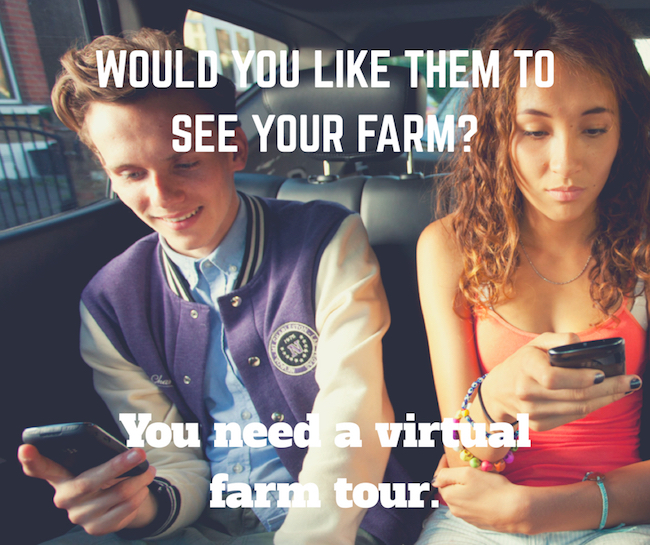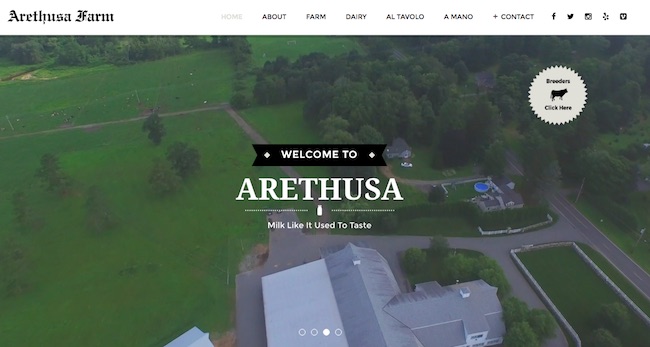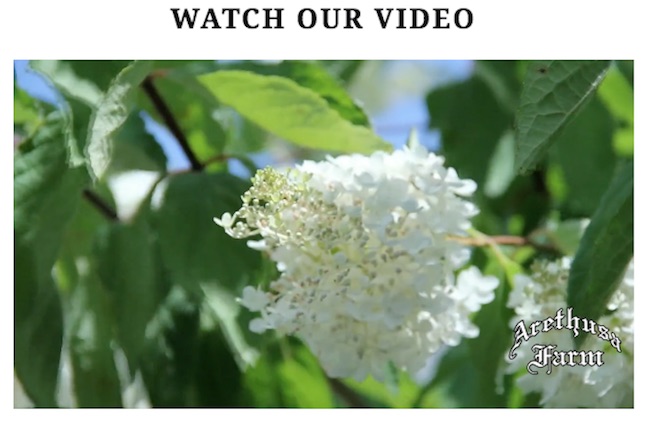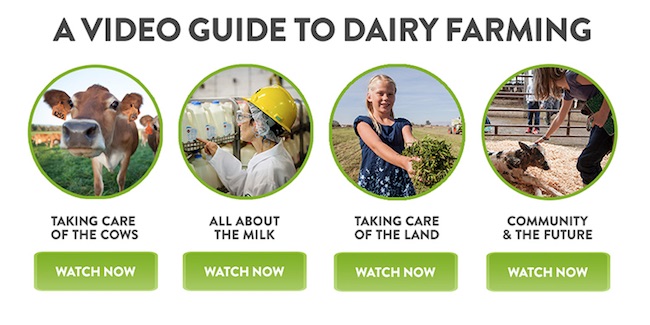As many of you know, most people have never visited a dairy farm, walked through a barn or met someone that works in agriculture. Right now their only experience with farming is from what they’ve seen on TV or on the Internet. Even school farm tours are declining as schools have to do cut backs on trips or it may be too much of an insurance risk to bring kids to the farm.

So how can we get more people to the farm? We need to provide them with the right information – and in a form they want to see it. And right now, people would rather see the farm on their mobile device or laptop than just read about it.
A virtual farm tour also allows for you to tell your story to them and build a human connection. While you might not think the farm is that exciting, to most consumers it’s an interesting place – very different than their urban or suburban lives. You can show them what you do, how you do it and why you do it – even if they never meet you face-to-face.
You have great stories to tell about your animals, your family, your business and your community involvement. A virtual tour can demonstrate your commitment to providing safe, wholesome products in a transparent and authentic way.
It builds trust in dairy and that’s what they need to feel good about consuming milk, cheese, yogurt and other products.
What is a virtual farm tour?
A virtual farm tour is a digital simulation of your farm. It uses a combination of videos or images to create an experience for the person watching online that is as close to in-person as possible.
Who should have a virtual farm tour?
I believe every farm should have a virtual tour.
Why?
Because then people can visit your farm (virtually) as many times as they like and, in fact, I would consider it one of your best advocates for spreading the good word about your dairy farm.
Another great thing about a virtual farm tour is that you can really control the shots and the questions you’ll answer. While you might be camera shy, it’s much easier to do a virtual farm tour then being in front of tens or even hundreds of people live.
What should be photographed or filmed for a virtual farm tour?
A virtual dairy farm tour is done a lot like a standard tour involving a live crowd except you’ll be writing, taking photos and filming the different parts.
It may take some time to do the tour but remember you’ll probably not have to do it again unless you’ve changed a lot on the farm.
And knowing how the farm is almost always on a plan for improvement, I would plan on doing a virtual farm tour every other year or so to keep it up to date.
Remember more people will probably visit your farm online then in person. It’s worth keeping it up to date as you improve the farm.
Where should you put your virtual farm tour?
Whether it be on your website, your Facebook page, YouTube, or even on your local dairy checkoff’s digital properties. Why you might even get your farm tour on your cooperative or processor plant’s digital presence. The entire dairy community needs more virtual dairy farm tours.
How should you do a virtual farm tour?
Here’s a checklist of most everything you’ll need to complete your virtual dairy farm tour. I’ll list these out and then we’ll explain each piece of the tour.
Virtual Dairy Farm Tour Plan
- Write out your station stories.
- Get the correct equipment.
- Create any necessary station signage or graphics.
- Shoot photos or videos of the different stations.
- Edit the station stories.
- Place the station stories online.
- Monitor the virtual farm tour for comments and questions.
1. Write out your station stories.
Ok, what’s a station story?
Station stories are the stories you will tell at each station you set up on the farm.
Stations you should consider setting up:
Overall Introduction to the farm
Family Values and Employees
Calving area
Barn / Housing
Cow Feed
Milking Parlor
Maternity / Hospital Barn
You have an amazing story to tell whether you think so or not. Many consumers have never been to a dairy farm and you’ll be their first experience. Which brings us to this question:
Who is your audience?
I recommend that you visualize who your consumer is when writing down your station stories. Your consumer – the person you would like to influence – is young, inquisitive, bright (but might not get farmer lingo) and is genuinely interested in life on the farm. They could be a woman or man or you could think of both of them standing before you and they would like to engage in both the tour and a question and answer time.
When it comes to thinking of your audience also consider your role. You are going to be their tour guide but you are also their guide to good dairy farm practices. You are their mentor and teacher and they are your prized students because if they understand you and like what you are doing they will pass along your information to their friends.
This may seem overwhelming to you. Imaging yourself a guide with students and then having to write out your station stories but your virtual farm tour doesn’t have to be very long.
In fact, we would recommend that for each station’s story that you’ll only think about one or two stories to write out. You’ll want to make the virtual farm tour clear and easy to understand to ensure that your story will be remembered. You will also want to keep in mind that if you are filming the story so you’ll want to keep each station under three or four minutes.
Which stories / stations should you write out?
a. The overall introduction
While sometimes people think it’s easy to introduce yourself, it might be much harder on camera or writing it out. But if you stick to the basics of what people want to know then you should be ok.
The basics:
What’s your farm’s name?
Where is your farm?
What’s your name?
What kind of farm is it?
How long have you been a dairy farmer?
How long has your farm been around?
How many cows are on the farm?
Why did you become a farmer?
Answer some questions that you normally get from a live tour.
Where are we going next on the virtual farm tour?
Here’s some examples.
“Our farm is about more than our family. It’s about our cows — they feed us, just as we feed them. They are our livelihood, and so we treat them all with care and respect, and keep them calm and comfortable, so that they produce one of nature’s best foods – milk.
Our farm is also about our employees, who work hard so that all of us can make a living. Our farm is also about caring for our land, air and water – and our community.”
“I’m a dairy farmer who has been in the same business for 33 years with my husband. We both grew up on dairy farms, so we have almost 50 years of background experience in something we are truly passionate for. We are dedicated to producing the most wholesome dairy product for all people! …
True happiness comes from something we really enjoy doing, so I hope you can enjoy our products we work hard to provide for all.”
As you can see, this is pretty simple. You can add your own personal story – maybe talk about how a storm rolled through and you rebuilt the farm or why the farm has its name.
b. Family Values and Employees
You should showcase your strong farmer values. It’s how you care for your employees and their families like you do the animals because it’s how you treat people that shows how you really care.
The basics:
Why do you farm?
How does the farm run?
How do you care for your employees?
What values do you share and act upon?
When you are doing your virtual farm tour, it’s important to emphasize how the farm has changed from the past. You should think about how you will mention what modern technology you use and why you use it as well as how your thoughts on environmental stewardship and sustainability. People want to know how you are caring for all aspects of your business – they know you need to make a profit but they don’t want that to happen at the expense of future generations.
https://www.youtube.com/watch?v=LVjn78u9e5Q
c. Calving Area
People love calves and it’s always an engaging part of the tour. I would worry less about focusing the camera on you and more on the calves and your engagement with them. Remember to emphasize that everything you do is to benefit the animals and their care. Here’s some questions you can answer about the calves.
The basics:
How old are the calves?
Where are the mothers? (if you have separate housing)
Why are calves in that type of housing?
How long do they stay in the housing?
What does a calf eat and how often?
What happens to male calves on a dairy farm?
d. Barn and Housing
Many people believe that barns are supposed to be red and have those round sloped roofs. They may not understand all the benefits of the type of housing you provide for your cows.
The basics:
What type of housing do you provide for your cows and why?
What happens during a normal day for a cow?
What do your cows sleep on?
How often do they sleep?
How can you tell a cow is content?
What are the different sections of your barn?
Is there any technology you use that helps maintain the help of the cows?
Would probably answer questions about eating habits here.
How do you keep your cows cool?
e. Cow Feed
Many urban consumers are told myths about what dairy cows eat on a regular basis. Now you can show them what you feed your cattle and why you’ve selected this type of feed.
The basics:
What do cows eat?
How often do they eat?
What do cows drink and how much? (it’s always good to make comparisons to things that consumers normally use like cows drinking up to a bathtub of water a day)
What’s an animal nutritionist and how often do you talk to them?
Where does the feed come from?
f. Milking Parlor
The milking parlor is where the magic happens. Milking parlors come in all shapes and sizes so you should explain why you choose your parlor and how it works to milk the cows. There’s lots of moving parts within the parlor so it would be best to break down how the system works from the cows entering the parlor to the milk getting into the tanker.
The basics:
How does your milking parlor work?
– each step
Do the cows liked to be milked?
How much milk does each cow give?
How many times a day do the cows visit the milking parlor?
Where does your milk go?
Are there any antibiotics in the milk?
How do you test the milk?
g. Maternity / Hospital Barn
Basically you are showcasing animal care at its finest level as you explain how you care for cows that are in process of giving birth as well as cows that aren’t feeling well and how you take special care of both.
The basics:
How often does a cow give birth?
How long are cows pregnant?
How do you help the cows if they have any issues?
How long are cows in the maternity pens?
How do you treat sick cows?
Are sick cows still milked?
What happens to the milk?
What happens to cows after they get better?
Who is your veterinarian?
How long does it take for a calf to stand up on his/her own?
How much does a calf usually weigh?
2. Get the correct equipment.
To shoot and edit a virtual farm tour, you’ll need some equipment. Now there are lots of choices out there on the market but you don’t need Hollywood digital cameras to make a high end production. Many smartphones are excellent choices for filming your virtual farm tour.
For low cost production:
I recommend using an up-to-date smart phone and a tripod (an add-on microphone helps as well). Many phones can handle both the filming and editing of video clips. There are also excellent online video apps to help with special effects. Even YouTube allows for some editing. My personal use is an iPhone 6 with iMovie.
For mid level cost production:
I recommend a good video camera, tripod and mic and then transferring the files to a computer and using Adobe Premiere or Final Cut to edit the videos.
For high end production:
I recommend hiring professionals to do all of this for you. They can handle all the shooting, editing and final rendering of your videos. It will cost more but the production values should be outstanding.
Don’t ignore the tripod and microphone – both of these tools will come in very handy when shooting your own videos. There a lots of decent ones on Amazon.
For tips in creating good video and photos for your virtual tour, check out these posts.
7 Videography Tips for Farmers
10 Photography Tips for Farmers and Foodies
3. Create any necessary station signage or graphics.
While you don’t have to create anything to be used in a shot or photo, some farm tours have used signage to help people understand that talking points for that station. You could also add these in a graphic in a video if you understand how to add video graphics during editing. If you are looking for signage for your farm tour or examples of what others have used, please check out this link.
4. Shoot photos or videos of the different stations.
Again, it’s not necessary to put together your entire storyboard of everything you are going to shoot for your video before you film. But sometimes it’s helpful to think of different shots that you may want to take of the station.
For example, if you are filming the calves, you might want to have B-roll (extra footage that you can use to show different angles) of calves drinking milk from bucket or bottles, footage from inside the calf hutch, calves playing around in the barnyard, the vet checking vitals on a calf, or whatever else you want to talk about when showing your virtual tour. I recommend at least three or four different shots of the station you are shooting.
5. Edit the station stories.
My personal favorite video editing application/software is iMovie. It’s easy to understand and use but is limited. For larger projects, Adobe Premiere is an excellent choice. If you don’t have either at your disposal, then I recommend that you use the editing software that came with the smart phone or camera and try and make the videos shorter as lack of B-roll or multiple shots can sometimes cause a viewer’s attention to wander.
It is also smart to think about putting a watermark or text mark with your farm’s name on the video to keep others from stealing the footage and using it in ways you don’t want them to. In iMovie and other video editing apps like Video Show, let you do this.
6. Place the station stories online.
The proper location for your virtual farm tour is important and should be geared to where your audience will most likely look for your videos or photos. Here are the locations I recommend.
- YouTube – This is where the majority of consumers will look for videos. You can create your own channel for your farm or talk to your state/regional checkoff about using their channels.
- Facebook Page – Having a Facebook Page is virtually a necessary in today’s communication. I recommend loading the videos onto your farm’s Facebook Page or you can talk to your state/regional checkoff about using their channels to host your videos.
- Farm Website – I recommend that your virtual farm tour be hosted on your website on a single webpage – embedding the videos from YouTube or Facebook. If you do not have a farm website, then I would talk with your state/regional checkoff about hosting the videos on one of their webpages on their website.
- There are many other video channels now available and I would view these as secondary to the ones listed above. You can upload videos to Instagram, Twitter, Snapchat, etc…
- When uploading videos make sure to turn the comments on but set the comments to be moderated so they don’t just automatically appear on the video platform. You can do this both on YouTube and Facebook.
7. Monitor the virtual farm tour for comments and questions.
After you have added your virtual farm tour videos to your website and social media channels, you’ll need to monitor them for comments and questions. It’s important that you answer them in a timely manner on social channels.
On YouTube, you may experience “trolls” or unanimous people that leave disparaging comments on your videos. The best course of action is to make sure the person is a troll or activist before deleting the comments. While it’s difficult to not get upset at these remarks, it’s important that you not get into an argument with these types of users.
If you have any questions about putting together your virtual farm tour, please feel free to reach out to me at don.schindler at dairy.org or your local state/regional checkoff.



Leave a Reply